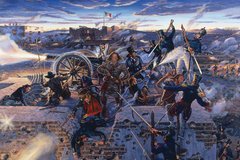Dr. R. Bruce Winders, Former Alamo Director of History and Curator
Young Texas came of age quite young
And then she married Uncle Sam,
She sewed her star fast to his flag,
And it shall shine there while there’s a rag.
— — “Uncle Sam & Mexico,” Rough & Ready Songster.
New York: Cornish, Lambert, & Co., ca. 1848.
One of the questions facing citizens of the Republic of Texas was whether or not to trade its status as an independent nation for a place within the federal union of the United States. President Mirabeau B. Lamar represented the faction strongly opposed to abandoning the Republic. Addressing the issue at his inauguration in 1838, Lamar said:
I cannot regard the annexation of Texas to the American Union in any other light than as the grave of all her hopes of happiness and greatness; and if, contrary to the present aspect of affairs, the amalgamation shall hereafter take place, I shall feel that the blood of our martyred heroes had been shed in vain…
Lamar’s pro-Republic stance, however, did not reflect the attitude of most Texans toward annexation.
Texans officially expressed the desire to join the United States shortly after the end of the Texas Revolution. In September 1836, voters made three important electoral decisions: They ratified the Constitution adopted at Washington-on-the-Brazos; they chose Sam Houston as the Republic’s first president; and they voted 3,277 to 91 in favor of annexation. Two controversial issues — the extension of slavery and a possible war with Mexico — proved to be major roadblocks to achieving statehood for nearly ten years.
By 1844, U.S. supporters of annexation had made progress in their plan to unite Texas with the United States. Diplomats from both nations negotiated a treaty that would allow Texas to join the Union, signing the document on April 12, 1844. On June 8, 1844, however, the Senate rejected the treaty by a vote of 53 to 16. But the issue was far from settled as it became part of the national debate during the presidential election that was heating up.
The Democratic Party promised to “re-annex Texas” as part of its platform. U.S. supporters, led by President John Tyler, arranged for the full Congress to take up the question once more in the form of a Joint Resolution that would bring Texas into the Union. Voting on February 27, 1845, the Senate approved Texas statehood, 27–25. The House of Representatives approved the bill on the following day by a vote of 132–76. The long-sought offer of annexation had finally been extended to Texas.
Texans responded quickly to the offer. President Anson Jones called a special session of Congress to advise him on the matter. Meeting on June 16, 1845, Congress authorized Jones to call for an Annexation Convention. Because of the significance of the date, the delegates voted to accept annexation 55 to 1 on July 4th. Jones then presented the annexation issue before the people of Texas, who went to the polls on October 13, 1845. The outcome of the plebiscite — 4,245 in favor to 267 against — showed that statehood was still preferred over continued existence as an independent nation.
Two official acts yet remained to finalize the deed. On December 27, 1845, U.S. President James K. Polk signed the annexation bill into law and formally recognized Texas as the 28th state of the Union. In a ceremony in Austin on February 19, 1846, Texas President Anson Jones ordered the Lone Star Flag lowered for the last time, proclaiming “the Republic of Texas is no more.”




